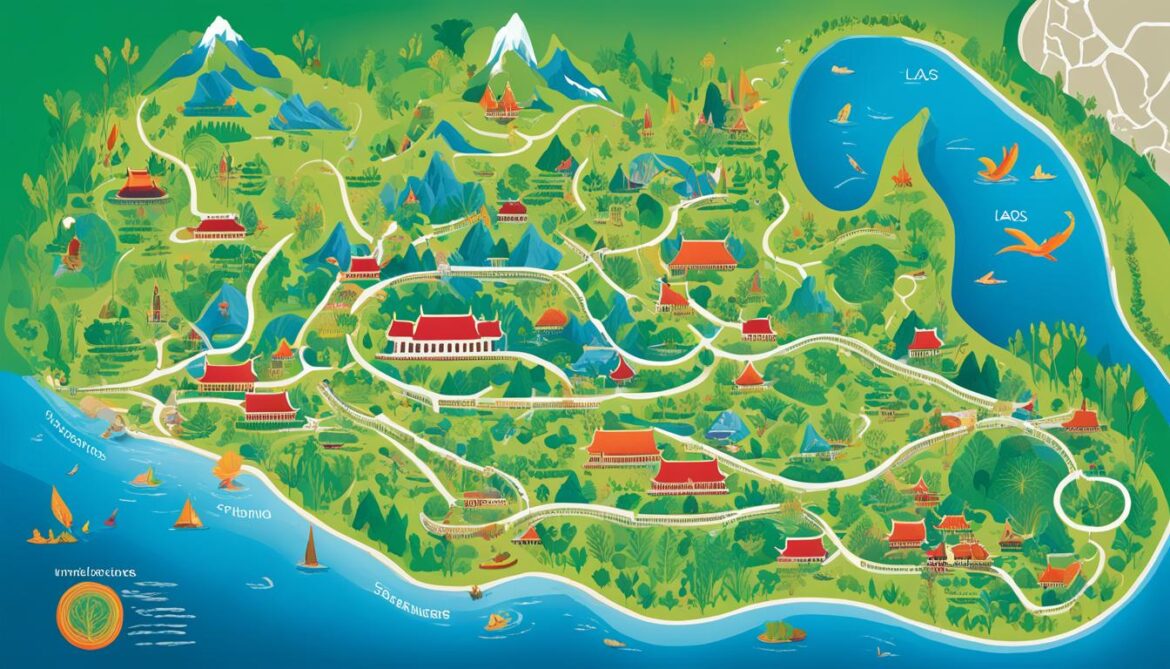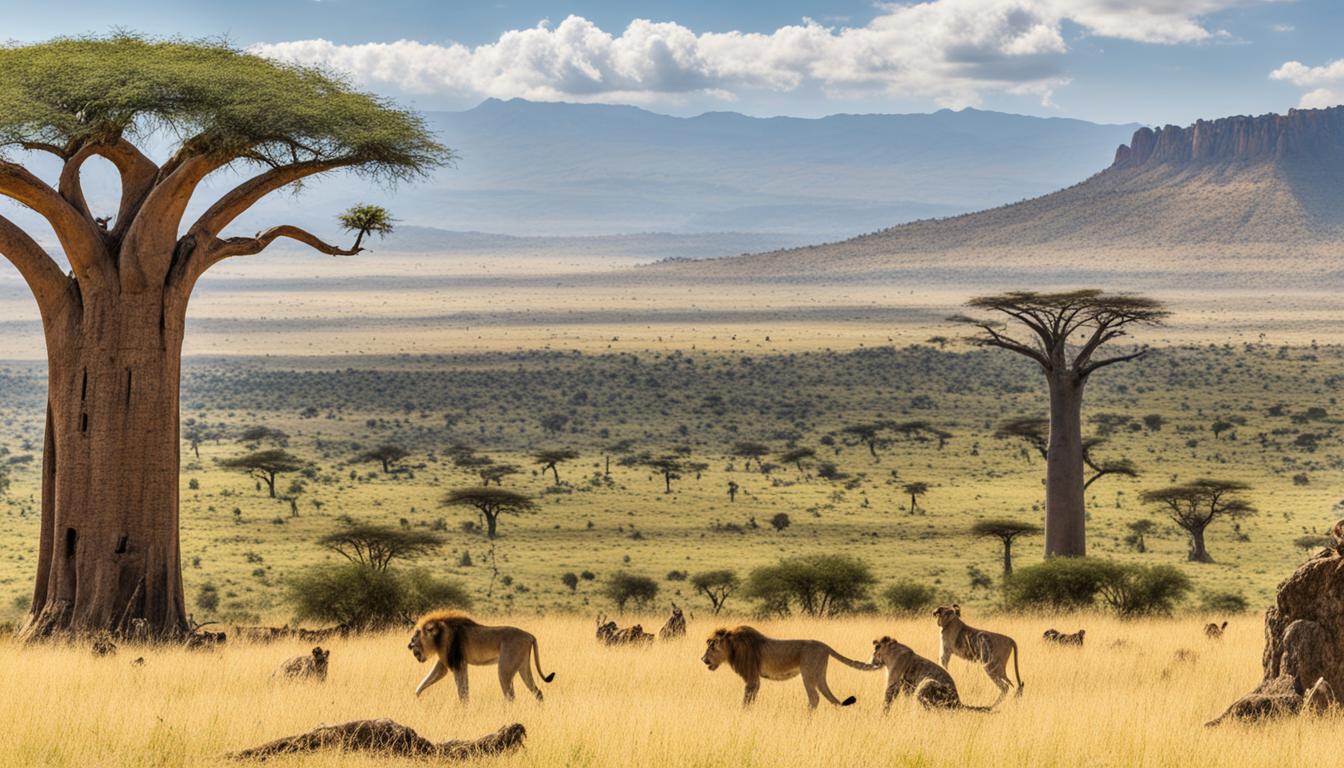Laos Sacred Natural Sites and Biodiversity
Did you know that Laos is home to a staggering number of species? With its diverse landscapes and ecosystems, this Southeast Asian nation boasts an impressive array of biodiversity. Laos is home to 700 bird species, 90 bat species, 500 fish species, 166 reptile and amphibian species, and over 247 mammal species. In addition, there are an estimated 8,000 to 11,000 species of flowering plants and a remarkable variety of glutinous rice varieties.
Unfortunately, this rich biodiversity is under threat. The destruction of habitats due to unsustainable resource use, agricultural expansion, and other human activities has led to significant biodiversity loss in Laos. Conserving this natural heritage is not only crucial for preserving the country’s unique plant and animal species but also for promoting sustainable development.
Key Takeaways:
- Laos is home to an incredible variety of species, including 700 bird species, 90 bat species, 500 fish species, 166 reptile and amphibian species, and over 247 mammal species.
- Biodiversity loss in Laos is a significant issue, primarily driven by habitat destruction caused by unsustainable resource use and agricultural expansion.
- Conservation efforts are crucial for preserving Laos’s rich biodiversity and promoting sustainable development.
- Protecting sacred natural sites is essential for the conservation of both biodiversity and cultural heritage in Laos.
- By recognizing the spiritual and cultural values associated with these sites, Laos can foster a harmonious blend of environmental protection and cultural integrity.
The Importance of Biodiversity Conservation
Biodiversity is crucial to the functioning of ecosystems and provides essential ecosystem services that sustain life on Earth. It plays a significant role in maintaining a balance between various species, ensuring the stability and resilience of ecosystems. Biodiversity contributes to processes such as water and air purification, waste decomposition, and flood control, among others. In addition, it supports the pollination of crops, natural pest control, and the production of medicines derived from plant and animal species.
The preservation of biodiversity is of utmost importance, not only for the well-being of the planet but also for humans. The loss of biodiversity can have severe consequences for food security, human health, and economic growth. For instance, the decline in pollinators such as bees and butterflies can reduce crop yields. The loss of natural habitats can lead to the extinction of plant and animal species, disrupting intricate ecological relationships and decreasing ecosystems’ resilience to environmental changes.
“Biodiversity is the living fabric of our planet, and without it, we face an uncertain future.”
The Case for Conservation
Recognizing the importance of biodiversity, Laos has developed a National Biodiversity Strategy and Action Plan to guide its conservation efforts. This strategy aims to identify and protect key biodiversity areas, promote sustainable land use practices, and strengthen the capacity for biodiversity conservation.
However, biodiversity conservation in Laos faces challenges due to limited capacities and resources. Enforcement of biodiversity conservation laws is often inadequate, leading to unsustainable practices such as deforestation, overfishing, and habitat destruction. Implementation of conservation strategies also requires collaboration and coordination between various stakeholders, including local communities, government agencies, NGOs, and international partners.
The Role of Sustainable Development
Biodiversity conservation in Laos is closely linked to sustainable development. By protecting and preserving biodiversity, Laos can ensure the long-term sustainability of its natural resources and promote economic growth that is in harmony with the environment. Sustainable development practices, such as responsible tourism and eco-friendly agriculture, can contribute to the preservation of biodiversity while providing livelihood opportunities for local communities.
Efforts should also be made to raise awareness about the importance of biodiversity conservation, both among the general public and policymakers. Education and outreach programs can help foster a sense of responsibility towards nature, encouraging individuals to make sustainable choices in their daily lives and supporting policies that prioritize nature conservation.
Overall, the conservation of biodiversity in Laos is a multifaceted challenge that requires commitment, collaboration, and innovative solutions. By prioritizing nature conservation and integrating it into development planning, Laos can ensure the preservation of its unique ecosystems and contribute to global efforts in protecting biodiversity for future generations.
Threats to Biodiversity in Laos
Biodiversity in Laos is under threat from various factors that endanger the delicate balance of the ecosystem. These threats include the over-exploitation of timber, illegal logging, expansion of agricultural areas, unsustainable slash-and-burn practices, hunting and fishing practices, and illegal wildlife trade.
Furthermore, social factors such as insecure land rights and unequal distribution of land contribute to the loss of biodiversity in Laos. The lack of clear land ownership leads to unsustainable land use practices, which further exacerbate habitat destruction and fragmentation.
With Laos’s emphasis on sustainable development, it is crucial to address these threats to biodiversity. Environmental factors such as floods, droughts, and landslides also pose challenges to biodiversity conservation. Climate change exacerbates these issues, putting additional pressure on ecosystems and the species that rely on them.
To achieve sustainable development and protect biodiversity, it is crucial for Laos to promote environmental protection and use natural resources sustainably. This can be achieved through targeted conservation efforts to mitigate habitat loss and degradation, implementation of stricter regulations to combat illegal logging and wildlife trade, and raising public awareness about the importance of environmental protection and sustainable practices.
By addressing these threats and adopting a holistic approach to environmental conservation, Laos can safeguard its rich biodiversity and contribute to a more sustainable future.
The Impact of Illegal Wildlife Trade
The illegal wildlife trade poses a significant threat to biodiversity in Laos. This illicit activity involves the trafficking of live animals, body parts, and products derived from endangered species. It not only drives the decline of numerous species but also contributes to the disruption of ecosystems and the spread of zoonotic diseases.
Laos must take decisive action to combat this trade by strengthening law enforcement efforts, increasing penalties for offenders, and raising awareness about the damaging effects of wildlife trafficking. Collaborative efforts with international organizations and neighboring countries are also crucial in tackling this transnational issue.

| Threats to Biodiversity in Laos | Impact |
|---|---|
| Over-exploitation of timber | – Deforestation – Loss of habitat for many species – Soil erosion and increased water runoff |
| Illegal logging | – Destruction of forest ecosystems – Loss of habitat for wildlife – Disruption of ecological processes |
| Expansion of agricultural areas | – Conversion of natural habitats to farmland – Fragmentation of ecosystems – Soil degradation and loss of biodiversity |
| Unsustainable slash-and-burn practices | – Loss of forest cover – Increased air pollution – Soil degradation and erosion |
| Hunting and fishing practices | – Decline of vulnerable and endangered species – Disruption of food chains and ecosystems |
| Illegal wildlife trade | – Decline of species population – Disruption of ecosystems – Spread of zoonotic diseases |
Addressing these threats and preserving biodiversity in Laos is crucial for the country’s environmental protection and sustainable development goals. By implementing effective strategies to combat these challenges, Laos can ensure the long-term health and resilience of its ecosystems and the valuable resources and services they provide.
Government Initiatives for Biodiversity Conservation
Laos is committed to protecting its biodiversity and preserving its rich cultural heritage. The country has implemented various government initiatives to address these important conservation goals. By designating more areas for protection than the global target for 2020, Laos is taking significant steps towards safeguarding its natural treasures.
As a signatory of the Convention on Biological Diversity, Laos has demonstrated its commitment to international cooperation in environmental preservation. The country has also developed a comprehensive National Biodiversity Strategy and Action Plan, which serves as a roadmap for conservation efforts.
Laos has integrated biodiversity conservation into various sectors through legislation and policy frameworks, ensuring that environmental protection is prioritized at all levels of governance. These initiatives aim to establish a harmonious balance between economic development and sustainable resource management.
However, despite these commendable efforts, challenges remain. Limited capacities and resources pose obstacles to the effective implementation and enforcement of conservation measures. More support and investment are needed to enhance the sustainability of these initiatives.
Nevertheless, Laos’s commitment to biodiversity conservation and its recognition of the importance of environmental protection are commendable. By continuing to prioritize and strengthen its government initiatives, Laos will contribute to the global efforts in preserving the planet’s natural heritage.
Government Initiatives for Biodiversity Conservation in Laos
| Initiative | Description |
|---|---|
| Designation of Protected Areas | Laos has designated more areas for conservation than the global target for 2020, demonstrating its commitment to safeguarding biodiversity. |
| Convention on Biological Diversity | As a signatory, Laos actively participates in international efforts to protect and conserve biodiversity. |
| National Biodiversity Strategy and Action Plan | Laos has developed a comprehensive framework that guides conservation and sustainability efforts. |
| Legislation and Policy Integration | Biodiversity conservation has been integrated into various sectors through legislation and policy frameworks. |

Sacred Natural Sites in Laos
In the lush landscapes of Laos, sacred natural sites hold a special place in the hearts of the local communities. These sites, often sanctified forests used as burial grounds or protected areas for spirits, serve as important habitats for biodiversity, showcasing the wonders of nature while preserving cultural heritage.
At these sacred natural sites, the delicate balance between biodiversity and cultural identity is maintained. Rare and endangered species find refuge in these protected areas, as they are subject to restricted access and experience less direct human impact. This unique harmony promotes the preservation of both ecological and cultural diversity.
Moreover, sacred natural sites in Laos offer recreational and educational opportunities. Visitors can immerse themselves in the serene beauty of these sites, breathing in the fresh air as they explore the wonders of nature. The educational value of these sites cannot be overstated, providing insight into the traditional beliefs and practices of the local communities.
“Sacred natural sites in Laos are the true embodiment of our heritage—where the natural world and the spiritual realm intertwine, enabling us to connect with nature in profound ways.”
Additionally, these sacred sites contribute to the economic growth of the region through the potential for eco-tourism. Visitors from around the world are drawn to the mystique and beauty of these sites, providing opportunities for sustainable economic development. By embracing and protecting these sites, Laos can promote both conservation and responsible tourism practices.

The Value of Sacred Natural Sites in Laos
To gain a deeper understanding of the significance of sacred natural sites in Laos, let’s explore the various dimensions of their value:
| Value | Description |
|---|---|
| Biodiversity Conservation | These sites provide vital habitats for a diverse range of plants and animals, contributing to the preservation of Laos’ rich biodiversity. |
| Cultural Heritage | Sacred natural sites are deeply intertwined with the traditional beliefs, practices, and cultural identity of the local communities, providing a glimpse into the country’s rich heritage. |
| Recreational and Educational Value | Visitors can engage in recreational activities such as hiking, birdwatching, and spiritual retreats, while also gaining insights into traditional knowledge and practices. |
| Economic Potential | Eco-tourism opportunities can generate income for local communities, supporting their livelihoods while promoting the conservation of sacred natural sites. |
Sacred natural sites in Laos are not only a testament to the thriving biodiversity of the region but also a testament to the profound connections between humans and nature. By safeguarding these sites, Laos can ensure the preservation of its ecological treasures and cultural legacy for generations to come.
The Role of Sacred Natural Sites in Biodiversity Conservation
Sacred natural sites play a crucial role in conserving the biodiversity of Laos and preserving its cultural heritage. These sites, often subject to restricted access, provide sanctuaries for rare and endangered species and play a significant role in maintaining the balance of natural ecosystems. By recognising and protecting these sites, Laos can promote the conservation of both its unique biodiversity and its rich cultural heritage.
One of the key reasons why sacred natural sites are important for biodiversity conservation is that they experience less direct human impact compared to other areas. Restricted access to these sites helps preserve their pristine conditions and protects them from activities that could harm the delicate ecosystems and species that reside in them.
The spiritual and cultural values associated with sacred natural sites also play a significant role in fostering a sense of responsibility and stewardship towards the environment.
These sites hold deep spiritual and cultural significance for local communities, who view them as sacred places. This deep connection encourages a sense of responsibility and stewardship towards the environment, leading to the conservation of these sites and the biodiversity they house.
By preserving sacred natural sites, Laos not only safeguards its unique biodiversity but also protects its cultural heritage. These sites serve as living testimonies to the beliefs and practices of generations past, providing a link to the country’s rich history and cultural identity. The conservation of these sites is, therefore, crucial for ensuring the continuity of Laos’ cultural heritage for future generations.

The Value of Sacred Natural Sites
The value of sacred natural sites goes beyond their contribution to biodiversity conservation and cultural preservation. These sites also have educational and recreational benefits, providing opportunities for people to connect with nature and learn about the importance of environmental stewardship.
Furthermore, sacred natural sites have the potential to generate economic benefits through sustainable eco-tourism. These sites attract visitors who are interested in experiencing the unique cultural and natural heritage of Laos. By developing eco-tourism initiatives around sacred natural sites, Laos can promote sustainable development while ensuring the conservation of these invaluable sites.
Through the recognition and protection of sacred natural sites, Laos can achieve a harmonious balance between environmental conservation and cultural heritage preservation, ultimately contributing to the country’s sustainable development.
Case Studies of Sacred Natural Sites in Asia
Across Asia, numerous case studies highlight the significance of sacred natural sites in preserving biodiversity and promoting environmental conservation. These case studies demonstrate the valuable role that spirituality and traditional beliefs play in protecting the natural world. Let’s explore some examples from Asia, including Japan’s sacred mountains and Mongolia’s sacred sites.
Japan’s Sacred Mountains
In Japan, sacred mountains hold deep cultural and spiritual significance. These mountains, such as Mount Fuji and Mount Koya, are considered sacred spaces and have been protected for centuries. They are believed to be inhabited by deities and are seen as gateways to the divine. As a result, these mountains are conserved, ensuring the preservation of their unique ecosystems and biodiversity.
Mongolia’s Sacred Sites
In Mongolia, a wide range of sacred sites exists, including mountains, lakes, and forests. These sites hold immense cultural and spiritual value for the local communities and are believed to be the dwelling places of ancestral spirits. The preservation of these sites is a priority for the Mongolian people, as they recognize their importance in maintaining environmental balance and biodiversity.
Sacred Natural Sites in Laos
Laos also boasts numerous sacred natural sites, which are of great cultural, recreational, and economic value. These sites include sacred forests, caves, and rivers, which are revered by local communities for their spiritual significance. They provide important habitats for diverse plant and animal species, contributing to the country’s rich biodiversity.
“Sacred natural sites in Laos support both cultural heritage and ecological diversity. By preserving these sites, we can protect both our natural and spiritual heritage and promote sustainable development.”
The development of eco-tourism in Laos allows visitors to experience the beauty and significance of these sacred sites. Eco-tourism not only provides economic opportunities for local communities but also raises awareness about the importance of conservation and sustainable development.

Comparison of Sacred Natural Sites in Asia
| Country | Types of Sacred Sites | Conservation Approaches | Impact on Biodiversity |
|---|---|---|---|
| Japan | Sacred mountains | Long-standing cultural practices, legal protection | Preservation of unique ecosystems, habitat for endemic species |
| Mongolia | Mountains, lakes, forests | Recognition of spiritual significance, community stewardship | Protection of environmental balance, conservation of rare species |
| Laos | Forests, caves, rivers | Sustainable tourism, community involvement | Preservation of biodiversity, habitat for diverse species |
“Across Asia, sacred natural sites demonstrate the powerful connection between spirituality, cultural heritage, and environmental conservation. By valuing and protecting these sites, we can ensure the preservation of our planet’s biodiversity.”
The case studies presented here exemplify the importance of sacred natural sites in Asia. These sites not only contribute to biodiversity conservation but also hold deep cultural and spiritual significance. By recognizing the value of these places and implementing sustainable practices, we can promote both conservation efforts and sustainable development in the region.
Linking Conservation with Spiritual and Cultural Values
The alignment of environmental conservation with spiritual and cultural values can lead to more sustainable practices. Sacred natural sites provide an opportunity to bridge the gap between conservation of biodiversity and cultural integrity. Traditional societies around the world, including in Laos, have recognized the special status of natural sites and their importance for maintaining both ecological and cultural diversity. By embracing and incorporating these values, conservation efforts can be more effective and holistic.
“The richness and diversity of nature are intertwined with the beliefs and traditions of local communities. Recognizing the spiritual significance of natural sites allows us to protect the environment while preserving our cultural heritage.” – Dr. Saranya Phounsy, Cultural Anthropologist
Biodiversity conservation and cultural integrity are interconnected aspects of sustainable development. When conservation efforts are guided by the spiritual and cultural values associated with sacred natural sites, it enhances the overall effectiveness of biodiversity protection. The conservation of these sites goes beyond the preservation of ecosystems; it encompasses the transmission of cultural knowledge, stories, and practices from generation to generation.
Sacred Natural Sites as Conservation Hotspots
Sacred natural sites often have restricted access and are less impacted by direct human activities. This makes them ideal sanctuaries for rare and endangered species and crucial habitats for biodiversity conservation. These sites provide refuge for diverse ecosystems, including forests, rivers, mountains, and wetlands. Furthermore, sacred natural sites can serve as corridors connecting fragmented habitats, promoting gene flow and ensuring the survival of species.
Studies have shown that sacred natural sites harbor higher levels of biodiversity compared to surrounding areas. The spiritual and cultural practices associated with these sites often involve sustainable resource use and conservation practices passed down through generations. These practices include taboos on hunting, gathering, and harvesting, as well as traditional ecological knowledge on ecosystem management.
“Sacred natural sites are windows into the past, preserving ecological and cultural heritage. These sites not only protect biodiversity, but they also safeguard the knowledge and traditions that have sustained our communities for centuries.” – Venerable Phouvieng Sayasin, Buddhist Monk
Incorporating the perspectives and practices of local communities in biodiversity conservation strategies can enhance the ecological, social, and cultural resilience of ecosystems. Through collaborative management approaches that respect the spiritual and cultural significance of sacred natural sites, both the needs of local communities and the conservation of biodiversity can be synergistically addressed.
The image above illustrates the interconnectedness of biodiversity conservation and cultural integrity, showcasing the diverse species and the cultural diversity found in sacred natural sites. It serves as a reminder of the importance of linking conservation efforts with spiritual and cultural values.
By actively involving local communities in the management and decision-making processes of sacred natural sites, conservation initiatives can gain greater support and become more sustainable in the long run. In addition, raising awareness among stakeholders and the wider public about the cultural significance of these sites can foster a sense of pride and ownership, ultimately adding to their protection and conservation.
Preserving Biodiversity and Cultural Heritage Hand in Hand
Recognizing the intrinsic value of sacred natural sites as both ecological and cultural assets is essential for achieving biodiversity conservation and cultural integrity. By embracing the spiritual and cultural dimensions of these sites, Laos can promote sustainable practices that ensure the long-term survival of its rich biodiversity while preserving its unique cultural heritage.
- Engaging with local communities and indigenous peoples in conservation planning and implementation
- Supporting initiatives that promote traditional ecological knowledge and practices
- Establishing protected areas and networks that incorporate sacred natural sites
- Integrating cultural values into environmental education and awareness programs
Through these concerted efforts, biodiversity conservation and cultural integrity can be nurtured hand in hand, creating a harmonious and sustainable future for Laos.
Governance and Management of Sacred Natural Sites
The governance and management of sacred natural sites in Laos require a collaborative approach involving local communities, government authorities, and other stakeholders. Recognizing the spiritual and cultural significance of these sites is crucial for their effective protection and management. By integrating traditional knowledge and practices into conservation strategies, implementing adequate legislation, and prioritizing capacity building, Laos can ensure the sustainable development and preservation of these sacred natural sites.
It is essential to engage local communities as custodians of these sites, as they possess invaluable traditional knowledge and practices that can inform conservation strategies. Through shared decision-making processes and the inclusion of indigenous perspectives, the governance and management of sacred natural sites can benefit from a more holistic and inclusive approach.
“Sacred natural sites hold immense cultural, ecological, and spiritual value for our communities. It is our responsibility to protect and preserve them for future generations.”
To effectively protect these sites, the government needs to establish appropriate legislation and regulations that recognize the cultural and spiritual significance of sacred natural sites. This legal framework should provide clear guidelines for their management and establish mechanisms for collaboration between different stakeholders.
Capacity building plays a crucial role in ensuring the effective governance and management of sacred natural sites. Training programs and workshops can be conducted to enhance the understanding of local communities and government authorities regarding the ecological, cultural, and economic values associated with these sites. This capacity building effort can empower individuals and organizations to actively participate in the conservation and sustainable development of sacred natural sites.
“By strengthening our capacity to manage sacred natural sites, we can contribute to both biodiversity conservation and sustainable development in Laos.”
Sustainable development goals should take into account the importance of sacred natural sites and their role in biodiversity conservation. Incorporating these sites into national strategies such as the National Biodiversity Strategy and Action Plan can ensure that their protection and management are integrated into broader conservation efforts. By recognizing the value of sacred natural sites in achieving sustainable development, Laos can strive towards a future where biodiversity and cultural heritage thrive hand in hand.
Management of Sacred Natural Sites: A Collaborative Approach
The governance and management of sacred natural sites in Laos require a collaborative approach involving multiple stakeholders. Local communities, government authorities, non-governmental organizations, and academics should come together to ensure effective protection and sustainable management of these sites. By pooling resources, sharing knowledge, and engaging in dialogue, a collaborative approach can help overcome challenges and ensure the long-term preservation of sacred natural sites.
| Stakeholder | Role |
|---|---|
| Local Communities | Provide traditional knowledge and practices, act as custodians |
| Government Authorities | Establish legislation, regulations, and management guidelines |
| Non-Governmental Organizations | Provide expertise, resources, and support for community-led initiatives |
| Academics | Conduct research, offer scientific insights, and inform management strategies |

“Collaboration and cooperation among stakeholders are essential for the effective governance and management of sacred natural sites.”
By working together, these stakeholders can develop comprehensive management plans, establish monitoring systems, and implement conservation measures that are culturally sensitive and environmentally sustainable. Regular communication and dialogue between stakeholders can ensure transparency, inclusivity, and accountability in the decision-making processes related to sacred natural sites.
The management of sacred natural sites is an ongoing process that requires adaptive management strategies. Regular assessments and evaluations can help identify and address emerging issues, incorporate new knowledge and practices, and adapt management approaches to changing circumstances.
“Through collaboration, we can strengthen the resilience of sacred natural sites and ensure their long-term survival for the benefit of both current and future generations.”
Ecotourism and Sustainable Development in Laos
Ecotourism has the potential to contribute significantly to the sustainable development of Laos, promoting both economic growth and environmental conservation. By attracting responsible travelers who value the preservation of natural resources and biodiversity, Laos can generate income that benefits local communities while also raising awareness about the importance of sustainability.
One of the key advantages of ecotourism is its ability to support the conservation of sacred natural sites in Laos. These sites, with their rich biodiversity and cultural significance, are often protected and managed by local communities. By promoting responsible tourism practices, such as minimizing waste and respecting local customs, ecotourism can provide financial incentives for the preservation of these sites while ensuring their long-term sustainability.
To ensure the success of ecotourism in Laos, it is essential to adhere to the principles of sustainability, cultural sensitivity, and environmental protection. Promoting community engagement and involvement in ecotourism initiatives is crucial for creating a sense of ownership and empowerment among local communities. Additionally, educating tourists about the value of Laos’ natural resources and biodiversity can foster a deeper appreciation and respect for the environment.
By integrating ecotourism into sustainable development strategies, Laos can harness the potential of its diverse ecosystems to benefit both the environment and the local communities. This can be done through partnerships between government agencies, local communities, and tourism operators, ensuring that ecotourism initiatives are aligned with the goals of biodiversity conservation and cultural preservation.
In conclusion, ecotourism presents a unique opportunity for Laos to simultaneously support sustainable development, preserve its natural resources, and conserve its sacred natural sites. By embracing responsible tourism practices and prioritizing environmental protection, Laos can establish itself as a frontrunner in ecotourism in the region.

The Benefits of Ecotourism in Laos
By embracing ecotourism, Laos can experience a range of benefits that contribute to its sustainable development:
1. Economic Growth and Poverty Alleviation
Ecotourism can stimulate local economies by creating job opportunities and generating income for communities in rural areas, where sacred natural sites are often located. This can help alleviate poverty and improve the quality of life for local residents.
2. Environmental Conservation
By promoting responsible tourism practices, such as minimizing waste and supporting conservation efforts, ecotourism can contribute to the preservation of Laos’ unique ecosystems and biodiversity. This can help protect endangered species and conserve natural habitats.
3. Cultural Preservation
Ecotourism provides an opportunity to showcase and preserve Laos’ rich cultural heritage. By promoting cultural sensitivity and involving local communities in tourism activities, ecotourism can help safeguard traditional practices and promote intercultural exchange.
4. Education and Awareness
Through ecotourism experiences, tourists can gain a deeper understanding of the importance of biodiversity conservation and sustainable development. This awareness can contribute to a broader global movement towards environmental stewardship.
| Benefits of Ecotourism in Laos | Impact |
|---|---|
| Economic Growth and Poverty Alleviation | Job creation and income generation in rural communities |
| Environmental Conservation | Preservation of ecosystems and biodiversity |
| Cultural Preservation | Safeguarding of traditional practices and promotion of intercultural exchange |
| Education and Awareness | Growing understanding of the importance of sustainability |
Conclusion
In conclusion, Laos’s sacred natural sites play a vital role in the conservation of biodiversity and the preservation of cultural heritage. These sites are not only important for maintaining the ecological integrity of the country but also for promoting sustainable development. By recognizing and protecting the spiritual and cultural values associated with these sites, Laos can create a harmonious blend of environmental protection and cultural heritage.
To ensure the long-term survival of Laos’s biodiversity and cultural diversity, it is crucial to enhance conservation measures. Efforts should be made to raise awareness about the importance of these sacred natural sites and to promote sustainable practices among local communities and visitors. By doing so, Laos can continue to protect its rich biodiversity and cultural heritage for future generations.
The sustainable management and preservation of Laos’s sacred natural sites can contribute greatly to the overall goal of conserving biodiversity. These sites serve as sanctuaries for a wide range of plant and animal species, providing them with a safe habitat to thrive. Additionally, the cultural significance of these sites fosters a sense of responsibility and stewardship towards the environment.
By prioritizing the protection of sacred natural sites and integrating conservation efforts with cultural values, Laos can achieve a balance between ecological conservation and sustainable development. This approach will not only safeguard the country’s natural heritage but also promote the well-being and prosperity of its people.
FAQ
What is the importance of biodiversity conservation in Laos?
What are the threats to biodiversity in Laos?
What government initiatives are in place for biodiversity conservation in Laos?
What are sacred natural sites in Laos?
What is the role of sacred natural sites in biodiversity conservation?
Can you provide examples of sacred natural sites in Asia?
How can conservation be linked with spiritual and cultural values?
How are sacred natural sites governed and managed?
How can ecotourism support sustainable development in Laos?
Source Links
- http://sacrednaturalsites.org/wp-content/uploads/2011/10/133358e.pdf
- https://www.giz.de/en/downloads/giz2014-en-10-facts-biodiversity-laos.pdf
- https://bioone.org/journals/mountain-research-and-development/volume-37/issue-2/mrd.mm205/Asian-Sacred-Natural-Sites–Philosophy-and-Practice-in-Protected/10.1659/mrd.mm205.full








